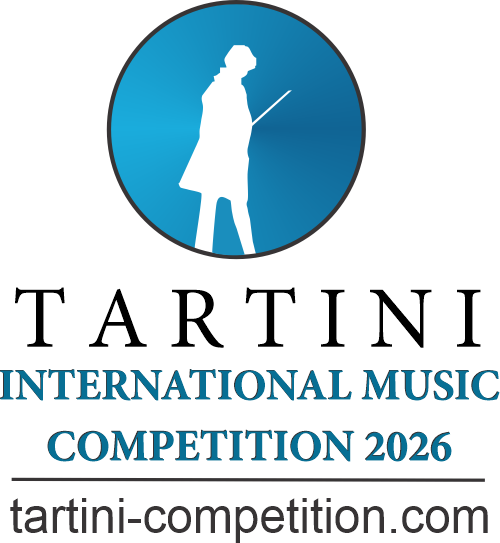Giuseppe Tartini
In 1715 the cardinal withdrew his objections to the marriage, and Tartini and his wife were reunited in Padua. In 1716 Tartini heard the violinist Francesco Maria Veracini in Venice and was so impressed with his playing that he sent his wife to relatives so that he could continue his studies in Ancona.
Giuseppe Tartini (1692-1770) was an Italian violinist, composer, and theorist. He laid the foundation of the modern school of bowing in a manner more "singing" than that of his contemporaries.
Giuseppe Tartini was born in Pirano, Istria, on April 8, 1692. At his father's wish he studied for the priesthood. In 1710 he entered Padua University as a law student, where he remained until 1713, when he secretly married a niece of Cardinal Cornaro, which led to accusations of abduction. Leaving his wife in Padua, Tartini took refuge in a monastery at Assisi, where he practiced the violin and studied music theory. Here he wrote the Trillo del diavolo (Devil's Trill), an attempt to reconstruct a sonata he said the devil had played to him in a dream. In 1714 he discovered the "resultant" tone, a means for improving intonation. While this tone cannot be heard on a modern violin, it is clearly audible on an old one with its smaller bass-bar and other fittings.
Giuseppe Tartini was born in Pirano, Istria, on April 8, 1692. At his father's wish he studied for the priesthood. In 1710 he entered Padua University as a law student, where he remained until 1713, when he secretly married a niece of Cardinal Cornaro, which led to accusations of abduction. Leaving his wife in Padua, Tartini took refuge in a monastery at Assisi, where he practiced the violin and studied music theory. Here he wrote the Trillo del diavolo (Devil's Trill), an attempt to reconstruct a sonata he said the devil had played to him in a dream. In 1714 he discovered the "resultant" tone, a means for improving intonation. While this tone cannot be heard on a modern violin, it is clearly audible on an old one with its smaller bass-bar and other fittings.
In 1715 the cardinal withdrew his objections to the marriage, and Tartini and his wife were reunited in Padua. In 1716 Tartini heard the violinist Francesco Maria Veracini in Venice and was so impressed with his playing that he sent his wife to relatives so that he could continue his studies in Ancona.
Tartini was solo violinist and director at S. Antonio in Padua (1721-1723) and chamber musician in Prague to Count Kinsky (1723-1725). Tartini returned to Padua in 1726. Two years later he founded a school of violin playing, which became known as the School of the Nations. Among his pupils was Maddalena Lombardi-Sirmen, to whom he addressed an important letter on performance which is mistakenly called the Art of Bowing by some writers. That title, however, refers to a series of variations Tartini wrote on a theme by Arcangelo Corelli. In the letter Tartini provides clear evidence that even the fastest notes were separated by a silence, which is not the case today.
Although Tartini's Treatise on Music, which dealt mainly with acoustics, was published in Padua (1754), it had less of an impact upon performance than his unpublished Treatise on Ornamentation (ca. 1750), which circulated widely in manuscript. Whole sections of it were incorporated into Leopold Mozart's Violin School (1756) without any acknowledgment, and it was published in French as Treatise on the Ornaments of Music (1771).
Although Tartini's Treatise on Music, which dealt mainly with acoustics, was published in Padua (1754), it had less of an impact upon performance than his unpublished Treatise on Ornamentation (ca. 1750), which circulated widely in manuscript. Whole sections of it were incorporated into Leopold Mozart's Violin School (1756) without any acknowledgment, and it was published in French as Treatise on the Ornaments of Music (1771).
Tartini wrote about 150 concertos and 100 violin sonatas with figured-bass accompaniment. They combined the dignity and serenity of Corelli with a passion and grace all his own. Tartini's violin works were technically more complicated and advanced than those of his predecessors. He died in Padua on Feb. 26, 1770.

Foto: ŽITKO, Duška: Giuseppe Tartini: 1692-1770 / Arhiv Pomorskega muzeja »Sergej Mašera« Piran.

Foto: ŽITKO, Duška: Giuseppe Tartini: 1692-1770 / Arhiv Pomorskega muzeja »Sergej Mašera« Piran.










 Austria
Austria Bosnia and Herzegovina
Bosnia and Herzegovina China
China Croatia
Croatia Czech Republic
Czech Republic Germany
Germany Greece
Greece Hungary
Hungary Italy
Italy Japan
Japan Latvia
Latvia Luxembourg
Luxembourg North Macedonia
North Macedonia Slovenia
Slovenia Serbia
Serbia Syria
Syria Romania
Romania Russia
Russia Ukraine
Ukraine United Kingdom
United Kingdom United Arab Emirates
United Arab Emirates



















